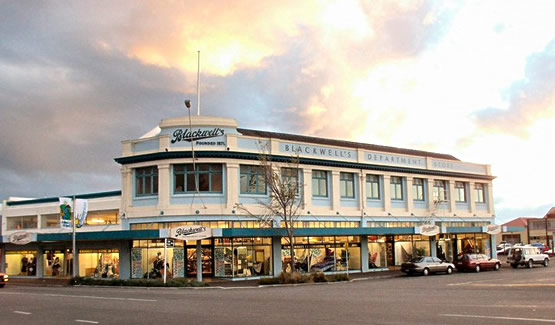Blackwell's Department Store - Kaiapoi
Contact Blackwell's:
Email us
The Blackwell Story

Bakery and delivery staff in front of Hilton Street Store bought by G.H. Blackwell from Mr A. Weston in 1874 and where the firm traded from until 1921. (Ernie Monk on front horse)
Chapters
- The Blackwell Story 1840 to 1868
- The Early Blackwell Store ~ 1871
- The Hilton/Black Street Store ~ 1873
- The Main Bridge Store ~ 1921
- Blackwell's Limited ~ 1924
- The Seventies to the century end
The Blackwell Story 1840 to 1868
Written by J.H. Blackwell
- 1840
- The founder of the business, Mr George Henry Blackwell, was born at Leamington, Warwickshire, England on 3rd September 1840. He was educated at the Leamington Primary School. At the age of 15 he enlisted in the Royal Navy on HMS Styx, a sailing ship serving on the West Africa Coast engaged in fighting against the slave trade.

Old Kaiapoi, a view of the South Side taken in the sixties, showing hotel/boarding house and shops on the present site of Blackwell's Department Store.
- 1861
- At the age of 21 he “bought out” of the Navy and was engaged in casual work in England for 18 months, including working on the railway then being completed from London to Oxford City. Late in 1862 he left Leamington, England for New Zealand, sailing on the emigrant ship Huntress and arriving in Lyttleton in March 1863.
- Immediately, on the 18th April, at 20/- per week, he engaged himself with his cousin Mr H. Kite who was a carpenter and wheelwright at Raven Street, Kaiapoi, who also did work in Christchurch. My father’s first job was to work on a house then being built in Black Street for Mr Michael Lynskey.
- In early 1868 J.H. Blackwell's fiannce Annie Shearsby arrived on the boat at Lytellton from Leamington, England. They were married shortly thereafer and moved into their home at 85 Raven Street, Kaiapoi. The house was bought from Matthew Hall (who later became the first mayor of Kaiapoi) for £53 which was reduced to £51 because cash was paid.
Personal note by J.H. Blackwell
“The details of the above early record off my father’s life were mainly found in an old worn, leather-bound pocket diary of his, after his death. On the front cover of the little book appears G.H.Blackwell, Lyttleton, Canterbury. Then Lyttleton has been marked out and substituted with the word ‘Kaiapoi’. This was also repeated on the back cover.
The book is about six by four inches in size and fairly well preserved but the leaves show much usage and are worn and the writing indistinct. Some of the earlier pages are in pencil and are faint and rubbed. The ink writing is clearer, but both ink and pencil pages have, in places, been written over and partly erased. The little diary was started in 1863 and the last entry was made in 1869.
It has not been an easy task to decipher, but enough has emerged to make clear the salient points of the life story of a young man who faced life in a new country confidently and courageously. He had no financial resources to assist his start but achieved what he did by virtue of his own energy, industry and integrity of character.”
[ Back to top ]
The Early Blackwell Store ~ 1871
- 1871/72
- About 1871 the Christhchurch railway was being extended, and reached Kaiapoi in 1872. Before that all road transport was by walking, horse, bullock dray and coach. The main northern route to Kaiapoi was via Peraki Street.
- When the railway came, the station location caused the old North Road to be straightened and it became the more direct access to the bridge at Kaiapoi. That central portion of the North Road was, in later years, renamed High Street.
- Mr G.H. Blackwell decided to enter business on his own account and in August 1871 opened a small general store naming it the “Railway Store”. It was on the North Road on the site now occupied by Wylie’s Drapery firm. So 1871 is the historical date of the commencement of trading of Blackwell’s Stores business. Fortunately we hold the stocktaking records of the first two years 1872 and 1873. The stocks in 1871 were listed at £325 including the horse cart and harness valued at £48. (Incidentally, one item is not listed – a son, Joseph Henry Blackwell, who had arrived in 1871!) In 1872 stocks were £547.
- The business was growing. The total assets were £1,011 including book debts of £381. The total liabilities to wholesale merchants were £790 leaving a credit of £221 for his two years work!
- The prices of food then include (per pound) butter 1/-, rice 4d., split peas 3d., sugar 5d., currants 6d., raisins 6d., hops 6d., coffee 1/4d. Eggs were 9d. dozen, candle cotton 1/9 per pound, starch 6d. and blacking 2/- dozen.
- Among the names of the customers of 1873 appear some whose descendants still trade with Blackwell’s today, over 90 years later.
- The majority of sales then were sold on credit necessitating financing credit to most customers by means of bank overdraft, and by himself receiving credit from wholesale merchants.
- It was a tribute to the regard in which he was held in those early days that he was able to arrange business finances on very slender resources. In an early Canterbury Almanac published in 1874, among the list of Kaiapoi businesses appears“G.H. Blackwell, Grocer, North Road, Kaiapoi”.
[ Back to top ]
The Hilton/Black Street Store ~ 1873
- 1873
- Late in 1873, after two years in the North Road, my father bought the business of Mr Alfred Weston, situated on the corner of Hilton and Black Streets, Kaiapoi. It had been one of the early Kaiapoi stores. In addition to grocery and some drapery and clothing lines it had a bakery and produce store and stable.
- There was a large two-storey building, the main wing for business and the other for house accommodation. The section was half acre with a roomy garden and trees. There he made his home and developed his growing business. He personally commenced regular rounds in the adjoining farming areas of Clarkeville, Eyreton, Ohoka and Woodend, thus starting the country connection which has always been an important feature in the Blackwell business.
- Of those early days one incident remains. About forty years ago, the late Mr Gibbs Stanton of Woodend, told me that he remembered my father calling at his farm on his rounds about 1875, when a swarm of bees attacked the horse and father had difficulty in controlling it.
- The business grew rapidly and additional staff was necessary. In my early boyhood recollections I can recall John Colman, baker, J.T. Burrows and John Wylie shop assistants and Mr H. A’Court, clerk. My Aunt, Fanny Blackwell, also helped on the drapery side, prior to her marriage to Mr Richard Evans.
- Those last decades of the 80’s were years of hard work and energy but Mr G.H. Blackwell built up the solid foundation on which his enterprise was established. He had his full share of business knocks and difficulties.
- Being generous to a fault, book debts became onerous and there was no Social Security until many years later. He was always a kindly employer and grew in public esteem. As with his business activities, he was always keenly interested in Kaiapoi’s progress and in public matters and in 1879 became Mayor of the town, an office which he held until 1881.
- 1878
- The Kaiapoi Woollen Company had been formed in 1878 and he was a member of its first directorate and became Chairman of Directors in 1881. He retained that position for 34 years until his death. A Press article of reminiscenses of those days states that “The first piece of tweed made by the Kaiapoi Mill was for sale in G.H. Blackwell’s Shop in 1878.”
- 1881
- Expanding business and the needs of his growing young family necessitated additional space. He brought the house property in Charles Street, which became the home for many succeeding years of his family of ten.
- At the shop, more room was made by replacing the part of the building formerly used by the family, and extending the drapery section.
- In the latter periods of the 1880’s, New Zealand’s business conditions experienced the fluctuations of that time. Trade generally was not buoyant, farm prices were low. The Kaiapoi Woollen Company experienced many teething troubles in its first years. Kaiapoi’s population was static and business required vigilant maintenance.
- I was then a schoolboy and was given odd jobs for the firm in my holidays. In 1886/7 I was twice sent to deliver supplies to Doubleday’s traction threshing mill at Bennett’s Junction. It was a long 40-mile trip with the old horse Taff, through country past Swannanoa, then still partly in tussock.
- Also, I was thrilled to be entrusted on Good Friday with part of the early 6 a.m. delivery of “Hot Cross Buns.” At odd times I assisted our baker John Colman to mill dairy butter – of different colours – on a big circular rolling table, the butter then being packed in kegs.
- 1888
- In 1888, after three years at the Boy’s High School, Christchurch, as the second generation of the family, J.H. Blackwell started work at the shop at 10/- per week and board.
- The staff then comprised T.B. Ward (grocery), F.W. Burrows (country rounds), John Colman (baker), J. Hayman (bread carter), Miss Edmonds (drapery) and myself (office). The hours of business were long, from 8 am to 6 pm with two late nights, Wednesday to 8.30 pm and Saturday to 10 pm and no half-holidays. The sales were mainly on credit, farmer’s accounts usually being settled annually after harvest. The booking system was elaborate involving much writing. Order books for the rounds were posted to daybooks, then again to the big ledger – all in detail. Customer’s accounts were rendered monthly or quarterly, all fully itemised. The items were usually small and the amount of writing was terrific. Our little office was very cramped, but four years later my father built a lean-to addition giving more room and better lighting.
- 1890
- A year or two later I got my first clerical help and office methods improved. By then a great boon was the Thursday half-holiday which father had persuaded all the shops to adopt in 1890. Also he had effected a further improvement by having the first well sunk by Job Osborne at a cost of £39. The depth was 315 feet which gave a steady flow of 16 gallons per minute to a 15-foot tank. This was later reticulated to several neighbours. Incidentally, it is in use today, over 60 years later.
- At this period of the late 1890’s, the Kaiapoi Woollen Company was going through critical times and claiming more of my father’s time and in consequence, added responsibility for the direction of the shop fell to me. Under his supervision I took over the ordering of the wholesale purchases and developed new lines of business with special attention to enlarging the scope of the drapery and clothing section. With him at hand for reference, I had taken charge of the general direction of the business at the time of my marriage in 1895. General business conditions in New Zealand were beginning to improve and population was increasing. The great Refrigeration industry, which had started in the 1880’s grew steadily more successful, giving stability and progress to the farming community.
- In the two decades up to the First World War, the New Zealand economy quietly and steadily prospered. Kaiapoi shared in the improved general business conditions. At the Blackwell Stores these were years of growing activity.
- 1892
- An old produce shed had been pulled down by father in 1892 and replaced by a large galvanised iron building giving adequate storage. Incidentally, this remained for thirty years until transferred in 1921 to our present site. In 1895 the old bakehouse and stable were dismantled. A large brick bakehouse was built. This was an important improvement. Under Mr H. Farrer's direction, our bread, cake and small goods business rapidly built up. New stables were provided at the same time.
- By this period our country rounds had increased and Coutt’s Island included. The heavy spring cart was replaced by a 2-horse wagonette. This was in the charge of Mr L. McVicar and later of Mr H. Cory. In later years, with the coming of the motor age, this was again superseded by a large motor truck in the charge of Mr E. Monk, who was our country salesman for over twenty years.
- 1902
- Early in 1902 Blackwell’s Stores installed improved shop lighting replacing kerosene lamps with acetylene gas. This proved very successful. It caused some anxious moments occasionally on late nights when flickering lights caused a rush to replenish carbide stock. However, in 1909 the Kaiapoi Borough installed acetylene lighting for the town.
- In 1898 my brother, Mr W.F. Blackwell, had started in our business, but left after eighteen months to go farming.
- In 1902 my brother Fred, (Mr A.T. Blackwell) also joined the business, but after three months got a position with Sargood, Son & Ewan, Christchurch. Some years later both joined in farming at Amberley.
- About 1922 Mr W.F. Blackwell founded Blackwell Motors, Christchurch and developed it into a most successful business during succeeding years. He died in 1969. He was an original shareholder in our firm when Blackwell’s stores became a private Company and was always keenly interested in our welfare.
- In those early years of the 1900’s our general departments grew steadily. Special attention was given to drapery and clothing developments. Buying facilities were improved and direct indenting established with London. More shop room became imperative. This was effected in 1902 by pulling down the smaller wing of the main shop building which had been partially used for housing the staff, and our replacing some of the large, brick, two-storey block. This housed the enlarged drapery and millinery sections on the ground floor and the dressmaking workroom upstairs.
- This dressmaking business had been started a year or so earlier under Miss Hollway and proved successful and within a few years had a staff of twelve. By this new development sales of dress goods had been helped, particularly of Kaiapoi Woollen Company’s materials. Kaiapoi costumes became a special feature and drew clients from a wide area.
- A millinery department was started under Miss Horsfall and quickly grew in turnover. Individually trimmed hats selected to personal taste were in vogue in those days and our section sold some hundreds annually.
- The general drapery section was in the capable charge of Mrs C. Wright who remained with our firm for over twenty years.
- The grocery section was mainly controlled by my uncle, Mr T.B. Ward of whose loyal service I cannot speak too highly.
- For some years Mr C.H. Wright was a capable salesman in various sections. Then in about 1902 he developed a new branch of our general produce business – bacon curing. We bought annually from four to five hundred carcasses of pigs from our farmer customers. These were processed by Mr Wright and his assistant into hams and sides of bacon and salt-cured. This was done in the old butter store with the smokehouse adjoining. We developed a substantial wholesale business in bacon and hams, especially with Auckland firms. The quality proved very satisfactory and we were urged to enlarge operations and install refrigeration to cater for regular trade all round the year, but too much finance would have been necessary and we needed all our capital to concentrate on our growing general business. Therefore we regretfully closed the bacon section after some years. Incidentally Mr C.H. Wright became town clerk of Kaiapoi later, and held that position for many years.
- In those first years of the decade of 1900’s New Zealand experienced growing prosperity. Especially important was the great development of the dairy industry and the establishment of Co-operative Manufacturing Companies. By new, improved methods the butter industry was revolutionised, materially raising the standard of the farming community. Prices of products were much improved and farmers received their monthly returns regularly. This was reflected in improved general business conditions. Blackwell’s Stores had become larger and shared in the general growth of New Zealand’s prosperity. Our main retail departments had steadily increased in turnover. The bakehouse was building up a wholesale trade. With the grocery section in full swing we had a staff of over thirty.
- 1912
- In 1912 the name of the firm was altered from G.H. Blackwell to J.H. Blackwell. My father was in failing health and the transfer was made by mutual consent. This meant I became the proprietor and took over full responsibility for the business though my father retained financial interest in the firm and always maintained his keen, personal interest in the business he had founded forty years before in 1871. He was pleased to know that his grandson Mr H.H. Blackwell was to follow the family tradition.
- 1914
- In 1914 he died, completing the story of a full life, the memory of which became a proud legacy for his family and all who knew him. Kaiapoi had never had a greater citizen. The public esteem in which he was held is summed up by Mr D.N. Hawkins in his book Beyond the Waimakariri, written in 1957 (see page 211):
- “Mr G.H. Blackwell proved himself to be one of those rare enthusiastic and energetic people around whom townships revolve. Without listing his interests at length, it may be said that he helped to encourage and promote the existence of almost every business, industrial, social, educational and sporting organisations in the town of Kaiapoi until his death in 1914, and his popularity was rewarded with the office of Mayor, which he occupied from 1879 to 1881.”
- WWI
- In August 1914 the country was plunged into the First Great World War. Great Britain and the whole Commonwealth responded at once to the “Call to Arms”, and New Zealand was fully committed from the beginning. Kaiapoi took its full share of local responsibility and every section of its social and business economy was geared to that end. Business necessities had to be carried on but the overwhelming drive was for the War and its urgent needs, and everyone helped.
- Mr J.H. Blackwell had had five years as Mayor from 1906 to 1911. He became Mayor again for eight years from 1915 to 1923, and with many others assisted in the numerous patriotic activities of those war years in the Kaiapoi district. The whole of New Zealand was involved in the many difficulties in the early war years and in the restrictions which followed. In Kaiapoi these were helped later to some extent by increased activities at the Woollen Mills for war demands.
- In 1914 the third generation of the Blackwell family came into the business, Mr Henry Hugh Blackwell. In 1915 he was able to join Ballantyne of Christchurch for some months gaining useful, practical experience in departments that proved very useful on his return to Kaiapoi. In those two years when the whole business atmosphere was overshadowed by the demands of war, he had set his mind that when age permitted, he would join the Royal Flying Corps, then in its infancy as a fighting arm of the Services.
- 1916
- After frustrating delays he had secured admission to Walsh Brothers Flying School at Auckland, the first air-training centre in New Zealand. He left Kaiapoi in February 1917 and after three months gained his wings. In May he went by boat to England for twelve months further training and was engaged in RFC activities over France and Belgium for the last six months of the war.
- In 1916 the North Canterbury Freezing Company was established with works at Kaiapoi. The output from this venture was to help Kaiapoi in the following years
- The coming of Peace and the return of the Forces closed a great era in World history. In New Zealand, Kaiapoi shared in the general relief. The fine work of the women’s patriotic organisation was recognised by the award of the MBE decoration to the Mayoress, Mrs J.H. Blackwell.
- 1919
- Mr H.H. Blackwell returned to Kaiapoi in June 1919 and resumed his position at Blackwell’s Stores. The next three years saw much business activity throughout the whole country. New Zealand and the rest of the Commonwealth shared in what was later called the “War-Boom Years”. The return of the men from overseas and the rush for civilian requirements created a tremendous, unsatisfied pressure on business. Demand was greater than stocks available. The prices of all primary products, wool, meat, butter and dairy supplies reached boom prices. Business turnovers swelled rapidly and prosperity seemed assured. The general happiness created by the coming of peace was real and universal. However, the prosperity created by the inflated economy of the world proved to be temporary. It lasted for some three years until 1922.
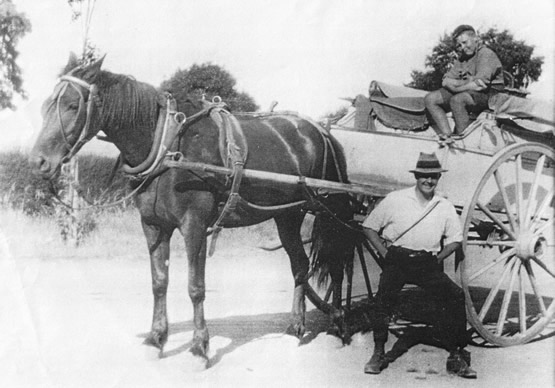
Bread delivery 1921, W.R. (Bill) Lintott with bread delivery cart eventually replaced by motorcycle and sidecar.
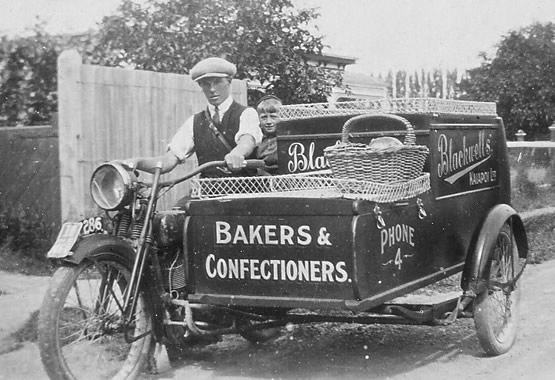
Blackwell delivery motorcycle and sidecar, 1920. Driver is Gordon Fisher, boy behind driver is Des Ashley.
[ Back to top ]
The Main Bridge Store ~ 1921
- Meanwhile, the return in 1919 of the junior partner of the firm encouraged optimism and serious consideration of its future growth. The old shop site on Hilton and Black Streets was not central and the growth of the town was towards the main bridge – High Street area. So in 1921 we decided on a forward move and bought the site at the junction of High Street and Raven Street from David Brown, then occupying it as a large boarding house and shops. These were pulled down and we erected the large brick two-storey premises which still remain our business centre. We built a large brick bake-house behind this block with access on Hilton Street. The large iron grocery bulk store was shifted from Hilton Street. The transfer of the whole business was a major transaction, giving us a position right in the centre of Kaiapoi.
- The old site at Hilton Street had a chequered career. Part was sold to Mr Tourell and still is his builder’s workshop. The shop building had been sold for a boarding house, but later came back on our hands. Some years afterwards the building was sold for housing flats and a shop which still remains.
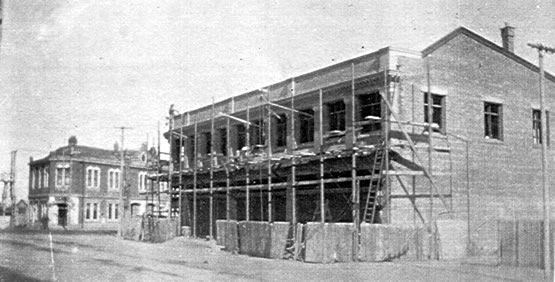
Construction of the Raven Street store in the early twenties.
- 1922
- In 1922 the great after-the-war slump hit New Zealand with its catastrophic effects. The bubble of inflation burst with little warning. Prices of primary products slumped, some being temporarily unsaleable. But wholesale and retail imported and manufactured lines were especially hit and some prices fell by half overnight. Retail stocks and prices had to be drastically cut and the whole atmosphere of business became chaotic. The ensuing depression lasted for years and caused much unemployment with the consequent lack of purchasing powers in the whole business world, which suffered severely. Many losses were experienced and trade was carried out amid many difficulties and anxieties.
- Though conditions slowly improved later, the effects of the slump were felt for many years. Our shop business at Kaiapoi had its full share of the difficulties of this period. The slump had come shortly after the erection of our new premises which had entailed more responsibilities and liabilities. Kaiapoi’s economic life was based on its industries and both the Kaiapoi Woollen Company and the Kaiapoi Freezing Works suffered very heavy losses. In both these companies Mr J.H. Blackwell was a director and these were very anxious years to maintain Kaiapoi's stability.
- In our own business, financial resources were strained to the limit to finance bank overdraft, to meet our requirements and to help customers during their own difficulties.
- Into our departments, Mr H.H. Blackwell put all his energies and took over increasing responsibility to maintain business and build up turnover. The usual counter sales were depressed but up-country trade was stimulated by establishing area lists of customers who could order by phone and get delivery daily by mail or train or bus service. A travelling drapery salesman canvassed the country areas with a weekly motor service.
- By these and other advertising methods he steadily built up the wider country connection which has always been a feature of our business. By personal canvass among our farmer customers he established a substantial indent business for horse and cow covers. Later, at his inception, our bakehouse section developed a wholesale trade in cake and small goods. We took a shop in Christchurch with a daily delivery van. This continued for some years until we sold the bakery business.
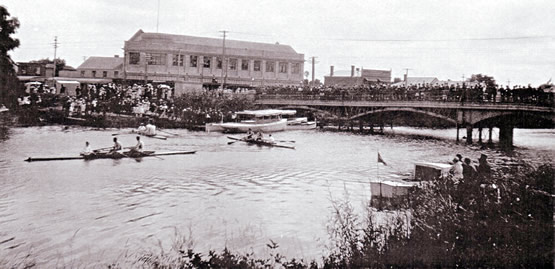
A river regatta in 1922 with the newly completed store in the background.
- 1927
- In 1927 a fire in upper storey broke out, doing serious damage to stock below. However, by H.H. Blackwell's vigorous dealing with the disaster, when insurances were adjusted, a special “fire sale” drew large crowds of customers with record results.
[ Back to top ]
Blackwell's Limited ~ 1924
- 1924
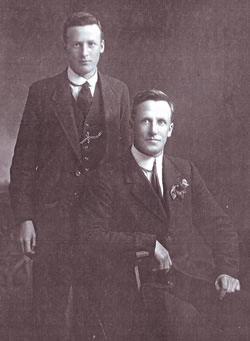 In 1928 a change
was made in our business structure and the name of J.H. Blackwell became
Blackwell’s Limited, a private firm, with J.H. Blackwell (seated in the photo at right) and H.H. Blackwell (standing) as
managing directors.
In 1928 a change
was made in our business structure and the name of J.H. Blackwell became
Blackwell’s Limited, a private firm, with J.H. Blackwell (seated in the photo at right) and H.H. Blackwell (standing) as
managing directors.- In that year the Kaiapoi Shipping & Trading Company had gone into voluntary liquidation. Their timber business had been steady for years, with timber mills and yards at Kaiapoi and Rangiora. Blackwell’s Ltd, bought these and operated them for some years, with Mr Meyer as manager under supervising control of Mr J.H. Blackwell.
- 1930
- In 1930 a major change in departments was effected. Owing to staff difficulties we disposed of the grocery department to Eric Gray who carried on the business in the same location, as our tenant, covering the same country areas with his rounds. This change was mutually satisfactory and still continues, Gavin Gray having taken over the tenancy on the death of his father.
- 1934
- In 1934, following on war slump losses, a serious attempt was made to close down the North Canterbury Freezing Works, a great threat to shareholders. This was averted by strenuous opposition and the industry was saved to Kaiapoi.
- Mr J. H. Blackwell became Chairman of Directors, and subsequent reorganisation stabilised the company which has enjoyed growing prosperity ever since. Mr J. H. Blackwell retired in 1956 after forty years as Chairman. In 1939 he decided to make his home in Auckland, continuing his business contacts with the shop and Freezing Works by regular quarterly visits to Kaiapoi.
- 1935/36
- Blackwell’s Limited decided to dispose of the bakery business, which was sold to Kennett and Son who took over the bakehouse as our tenants, later purchasing the property. Also we disposed of the timber business which had suffered in the building slump of 1935/36. We sold the mills and stocks at Rangiora and Kaiapoi to the Papanui Timber Company. Our firm was thus concentrating on its present retail departments under the direction of Mr H.H. Blackwell, principal managing director. Also we decided to complete reorganisation of our capital structure.
- The disastrous effects of the World War slump descended on our firm shortly after the building of the new shop premises in 1921. These carried new mortgage and financial liabilities which had to be met regularly. While wages and staff needs were always priorities, the substantial trading losses on stocks and turnovers, with severe depreciation in property valuations in those difficult years fell on the proprietors and shareholders. The Directors had cut their salaries to the bone.
- 1938
- We decided to clear the decks of deadwood timber. We cleared the balance sheet of accumulated losses and wrote down properties to Government valuations. To effect this we reduced our share capital by half. This was done with the unanimous agreement of all shareholders.
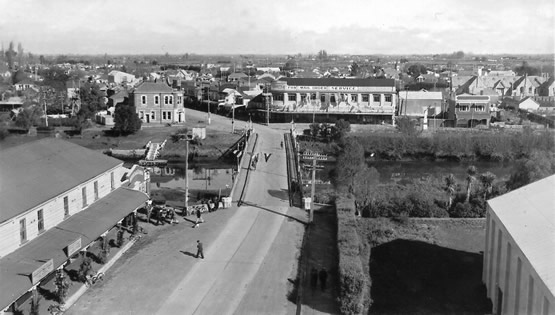
Blackwell's Store in 1938, showing the sign on the store front top "For Mail Order Service"
- 1939
- Business was showing satisfactory signs of improvement, when in September, 1939 Hitler struck and the whole nation was at once plunged into the Second World War and New Zealand for the second time experienced disruption. Mr H.H. Blackwell immediately offered his services to the Air Force and was appointed to the administration Branch at Harewood, and later became CGI (Chief Ground Instructor), with the rank of Flight Lieutenant and was later promoted to Squadron Leader. These responsibilities he retained at Harewood and later at Ashburton for the whole period of the war – five years.
- During this time the shop continued with a smaller, loyal staff and for a time under a manager with oversight regularly by Mr J.H. Blackwell.
- 1945
- When peace came in 1945, fortunately it was not followed after war results of the First World War, but turnover had been slow with considerable restrictions and shortages of stock. When Mr H.H. Blackwell resumed his direction of business activities, he vigorously developed the opportunities offered by the general return to Peace. The Government relaxed restrictions on trading and granted special licenses for much needed merchandise from Great Britain to men of War Service to increase business. He was able to build up stocks for the various departments which speedily secured substantial increase in turnover. The general purchasing power of the whole community was stimulated and our business shared in the growing prosperity. With the assistance of a loyal staff the enlarged facilities of the new shop building came into their own in the next few years. Then the upper storey was leased to Lichfield Shirts employing up to sixty machinists making shirts and blouses. Mortgage liabilities were progressively eased and after some years entirely paid off.
- 1947
- 1948 opened another important chapter on our business story when David Hugh Blackwell, the fourth generation of the family, started with the firm. He had had some eighteen months experience working with Beath and Company in Christchurch. Early on he gave special attention to building up the furnishings and furniture sections, which soon progressed into becoming one of our main departments. He became a director and has steadily assumed more responsibilities in management.
- 1956
- In 1956 an important advance was registered by the enlargement of the shop by substantial additions to ground floor space. Large showrooms were built and new fixtures added and the whole shop modernised. But the story of this progressive step and those in the following years are better left to be recorded by the later Directors who effected them.
- Since that time the following years for Blackwell’s Limited have shown steadily increasing prosperity which has been shared by directors, shareholders and staff. This satisfactory position has been secured by the resolute facing of the difficulties of the hard years with their anxieties and strains. Success has been secured by the efficient management and driving force of Mr H.H. Blackwell which has been, in later years so ably assisted by his son, Mr D.H. Blackwell.
- 1960
- “My last part of the story is to record the very pleasing occasion in 1960 when the Directors were able to recognise the strong position of our company by notifying shareholders of a bonus issue of shares doubling the total capital and restoring previous losses. Blackwell’s Limited still remains a private company, the shareholders all being connected with the family.
- In finishing my story of the Blackwell business, I have enjoyed refreshing my memories of days past. I have been part of the story and am proud to have been one of the four generations of Directors. I hope the third generation Directors will amplify and add to the story of his crucial period of responsibility. I hope that the fourth generation Director will begin at his ‘stepping into the ring’ and fill out the story of what he has already done and the plans for the Centennial Celebrations in 1971.
- I think all Directors can feel pride in this story.”
- — J.H.B. October 1962.
I always enjoy contacts with the present staff members. I have many memories of earlier members among whom I especially regard Mr T.B.Ward, Mr Chas. Wright, Mr H.W.Farrer, Miss Hollway, Mrs Bruce Forrest (Miss Knight), Mr C.F.Meyer and (later) Mr A.Bell. All gave long, valued service and become personal friends. This applies also to our long business connection with Mr Eric Gray and Mr Gavin Gray
[ Back to top ]
The Seventies to the century end
The Bridge Store as it stood in August 2001.
- 1971
- To complete its first century as a family business, the firm built a modern reinforced concrete addition on its High Street property, adding a further 2,500 square feet of ground floor space, plus 1,000 square feet of mezzanine floor and giving direct access to all departments. The vacant propoerty on High St was purchased from Algar Burgess after their fruit and vegetable shop completely burnt down (circa 1965). A Centennial banquet was held at the Island Tea Room on August 28th.
- 1975
- The Menswear Department moved into the 1200 square feet of grocery floor space previously occupied by Eric Gray & Co. The old Menswear was refurbished into a new sports, fishing and travel goods department. Hugh Blackwell died in July 1975 and his wife Mrs J.K. Blackwell was appointed a director. In 1979 Mrs. A. J. Blackwell also become director.
- 1980
- Mr A. W. Blackwell, the 5th Generation, joined the Firm.
- 1981
- 110th Anniversary included repainting of the interior walls and ceilings and installing fluorescent lights to create one modern uniform store.
- 1988
- Mr. M. H. Blackwell, the 5th Generation, joined the Firm after completing a BA Degree
- 1993
- David Blackwell retired after 46 years in the business in 1993, and Andrew Blackwell was appointed Managing Director and Michael Blackwell Company Secretary and Office Manager. The 5th Generation is now actively involved in directing the business. Photo at right shows Andrew (left) and Michael Blackwell in 2011.
- 1989 to 1996
- Extensive refurbishing and remodeling of the interior and exterior of the store was carried out.
- This brought the store up to the fine modern department store it is today, ready for its 125th Anniversary and the continuing rapid development of Kaiapoi and North Canterbury.
- The pattern of the years is not complete without placing on record the wonderful support of our Customers and Staff – both past and present – who have so loyally supported the Firm throughout the years.
- 2007
- Michael and Andrew Blackwell, the fifth generation to hold the reins of the store, pictured next to the old National till which was still operational in 2007. Tradition, service, quality and loyalty have kept the doors of one of New Zealand's oldest family-owned department stores open, for 135 years.
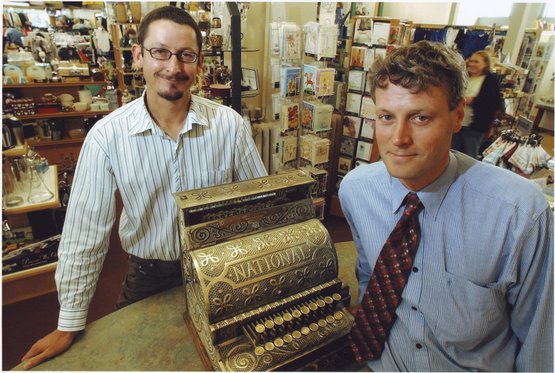
To be continued…
Word processing of the original history document this page is based on was done by Noeline Leslie in August 2001.
[ Back to top ]
Social Links & Friends
Video above shows the front of Blackwell's Store being made safe after the September earthquake
Blackwell's on the web
Before After Exhibition – images of Blackwell's Dept. Store are to be included in an exhibition at the Christchurch Art Gallery (now postponed).
Kete Waimakariri – the community heritage site started by the Waimakariri District Library includes a section about Blackwell's Dept. Store, including video and photos.
Kaiapoi Trade Directory - good site supporting local Kaiapoi trades people.
